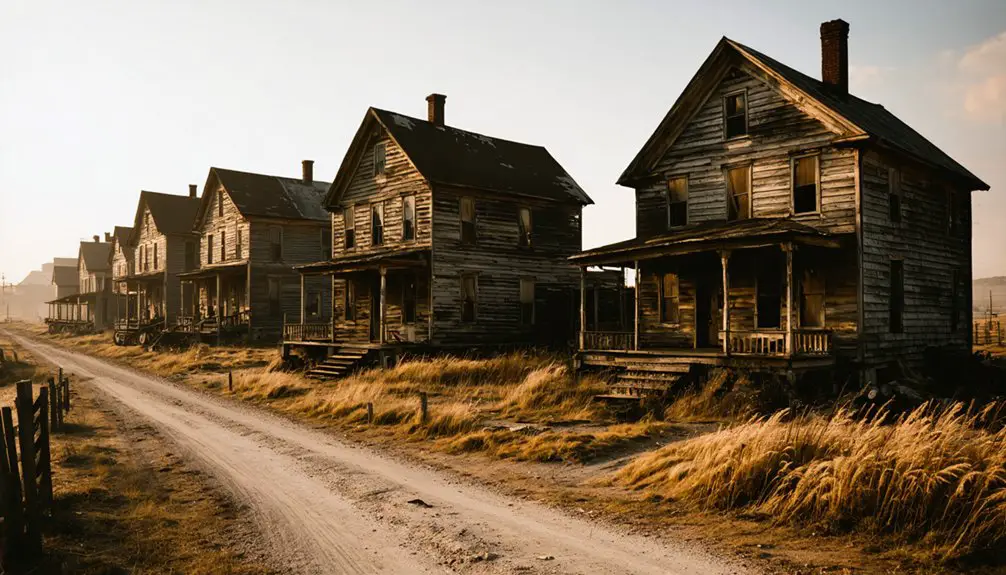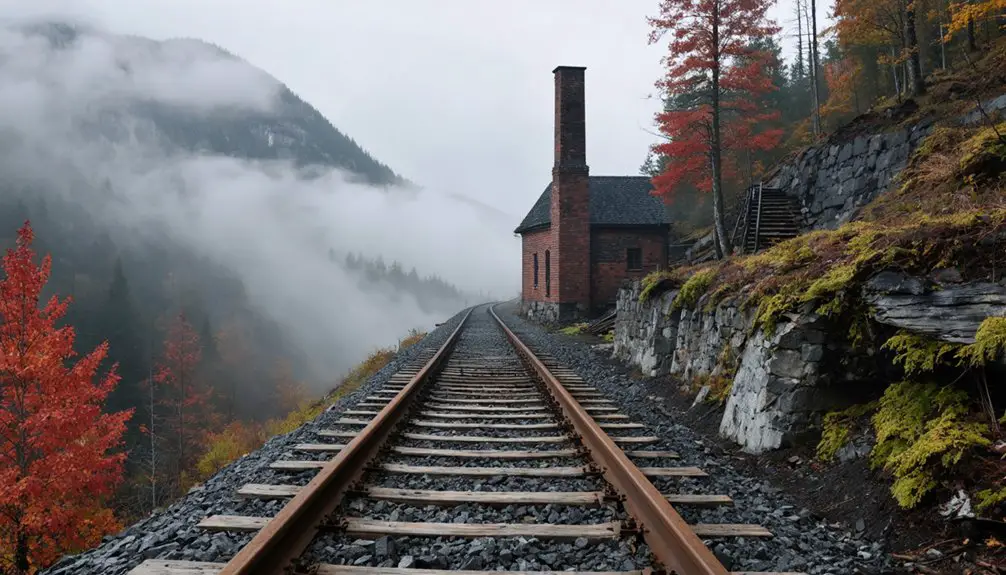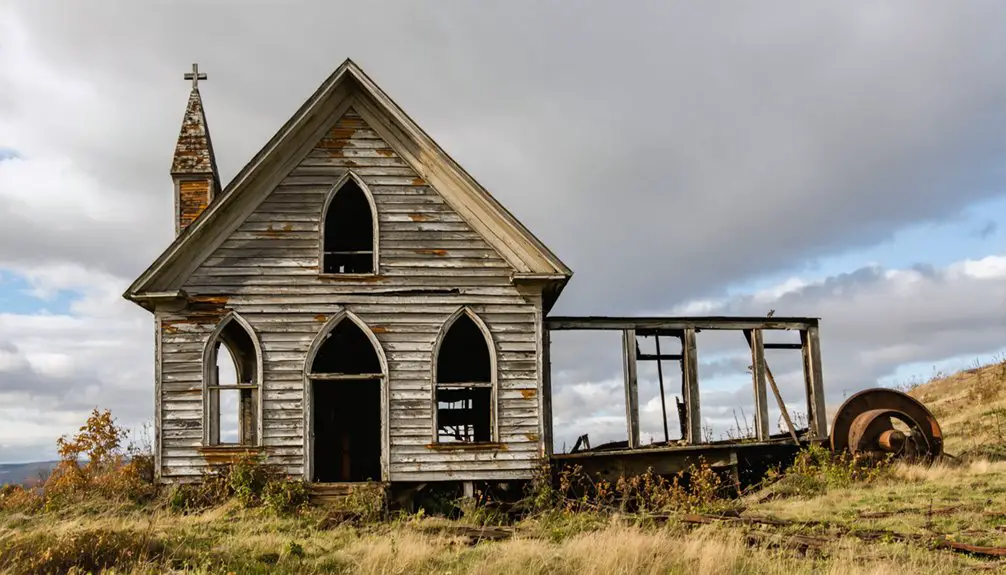You’ll find Claghorn along Indiana County’s Ghost Town Trail, where it emerged as a company town during Pennsylvania’s coal mining era. Built by Lackawanna Coal and Coke Company in 1903, it briefly thrived with 84 company houses, a three-story hotel, and a bustling company store. The town’s mining operations lasted only until 1904, though some residents remained until after WWII. Today’s trail markers and historic bridge preserve Claghorn’s rich coal heritage story.
Key Takeaways
- Claghorn was a Pennsylvania company town established between 1880-1930, built to support the bituminous coal mining industry.
- Mining operations lasted only from 1903-1904 under Lackawanna Coal and Coke Company before economic challenges forced closure.
- The town featured 84 company-built houses, a company store, school, and three-story hotel during its brief operational period.
- By 1924, Claghorn became a ghost town following mine closures, though some residents continued renting homes until after WWII.
- Today, Claghorn’s remains can be viewed along the Ghost Town Trail, including the historic 1924 bridge and interpretive markers.
The Birth of a Coal Company Town
During the early 20th century, Claghorn emerged as one of several company towns in Indiana County, Pennsylvania, built to support the region’s booming bituminous coal industry.
You’ll find it nestled along the railroad corridor now known as the Ghost Town Trail, where its establishment marked a significant economic impact on southwestern Pennsylvania’s development between 1880 and 1930.
The coal company’s grip on Claghorn was absolute – they owned every building, controlled the stores, and monitored daily life through company police.
From housing to groceries to law enforcement, the coal company maintained total domination over Claghorn’s daily operations.
While this arrangement provided essential housing and infrastructure for miners and their families, it also restricted personal freedoms.
The town’s cultural significance stemmed from its role as a self-contained community, where life revolved around mining shifts and company-sanctioned activities.
Everything from housing assignments to retail purchases fell under strict corporate oversight.
Like the nearby town of Warren Delano’s Wehrum, Claghorn represented the era’s typical pattern of industrialist-controlled communities.
Mining operations faced constant dangers, with deadly explosions occurring in neighboring towns in the early 1900s.
Rise and Fall of Mining Operations
Mining operations in Claghorn flickered briefly before extinguishing entirely in 1903-1904. You’d find the Lackawanna Coal and Coke Company struggling against fierce economic fluctuations that rocked the early 20th-century coal market.
As larger producers dominated the industry and alternative energy sources emerged, Claghorn’s mining sustainability became increasingly questionable. The State Line and Sullivan Railroad, under J. Raymond Claghorn’s presidency, initially provided crucial transportation infrastructure for the region’s mining ventures. The challenges proved insurmountable. With minimal infrastructure and costly deeper seam extraction, you couldn’t maintain profitable operations in this small company town.
When the Lackawanna Coal and Coke Company reassessed its holdings, Claghorn’s fate was sealed. Unlike its neighbor Wehrum, which lasted until 1929, Claghorn’s mining venture survived barely a year.
As operations ceased, residents quickly departed, leaving behind a ghost town that exemplified the harsh realities of Appalachian coal mining‘s boom-bust cycle.
Life in Claghorn’s Heyday

Life in Claghorn bustled with activity during its brief but vibrant peak. You’d find yourself surrounded by closely-built company houses where neighbors shared daily life, tending to small garden plots and gathering for social events.
The company store served as your central hub, where you’d exchange news while picking up supplies.
Local traditions centered around church activities and school functions, where you could join community celebrations, picnics, and informal sports matches. Similar to the town of Centralia, residents enjoyed a close-knit community of around 1,200 people.
While mining dominated employment, you might’ve worked in supporting roles like equipment repair or at local shops. Like nearby Wehrum, many miners faced the constant threat of deadly gas explosions in the mines. You’d rely on visiting doctors for medical care and deal with basic sanitation systems.
Despite these challenges, you’d find strength in tight-knit community bonds, whether at religious services, educational programs, or seasonal festivities that brought everyone together.
Town Layout and Infrastructure
If you’d visited Claghorn during its peak years, you would’ve found 84 company-built houses arranged near a central cluster of community buildings that included a 22-room hotel, combination school-theater, and company store.
The Pennsylvania Railroad‘s Ebensburg-Black Lick line ran directly through the town, providing essential transportation for both coal shipments and passengers.
The town’s layout maximized efficiency by positioning residential blocks and community structures parallel to the railroad tracks, creating a compact, walkable mining community typical of early 20th-century company towns. Construction of the town began in 1903, but economic challenges led to its partial completion and eventual abandonment after mine closures in 1924. Today, visitors can explore these historic remnants along the Ghost Town Trail, which preserves the memory of Pennsylvania’s industrial past.
Housing and Living Quarters
Through its development from 1903 to 1916, Claghorn’s residential landscape took shape as a carefully planned company town featuring 84 modest worker houses.
Initially built by Lackawanna Coal and later completed by Vinton Colliery Company, these dwellings formed the heart of a self-contained mining community.
You’d have found basic housing amenities typical of the era – coal heating and electric lighting – though indoor plumbing wasn’t standard.
The houses, arranged in efficient blocks near the Pennsylvania Railroad line, remained as worker rentals even after mine operations ceased.
Like Wehrum’s layout which included six parallel streets, Claghorn’s housing was organized in an orderly grid pattern for maximum efficiency.
The community sat along what is now the Ghost Town Trail, which preserves the region’s rich industrial heritage.
Each home offered walking access to essential services like the company store, hotel, and school/theater building.
While modest by today’s standards, these dwellings represented the backbone of Claghorn’s tight-knit industrial community until its post-World War II abandonment.
Community Buildings Layout
Claghorn’s community layout revolved around key structures that shaped daily life in this coal mining town. At the heart of the settlement, you’d find the company store, which served as the primary commercial hub for residents’ daily needs.
The impressive three-story hotel, featuring 22 rooms, stood as a landmark of architectural significance near the main thoroughfare. The nearby yellow bridge offered residents a picturesque view of the surrounding landscape.
The combined school and theater building exemplified efficient space utilization, serving as both an educational center and an essential community gathering spot.
While specific church locations aren’t documented, religious buildings likely occupied prominent positions on the town’s periphery or elevated areas.
All these structures were strategically positioned along the Ebensburg-Black Lick railroad line, ensuring easy access for both residents and visitors while facilitating coal transport and supply delivery.
Railroad Access Points
Railroad access shaped Claghorn’s development as an essential coal mining settlement along the Ebensburg-Black Lick line.
You’ll find the town’s infrastructure carefully positioned around the rail station, which served as the primary transportation hub for both coal shipments and passenger service. The railroad expansion brought standard features like passing loops and freight loading facilities, making it easier for mining companies to transport their coal efficiently.
Despite the access challenges posed by Pennsylvania’s rugged terrain, engineers designed track layouts that could handle heavy coal traffic while maintaining manageable grades.
The station included essential facilities such as a signal tower for traffic control and sidings where empty coal cars could wait to be loaded. Multiple platform tracks enabled simultaneous freight and passenger operations, keeping the community connected to surrounding markets.
Abandonment and Modern Remnants
As the coal industry faltered in 1924, Claghorn’s transformation into a ghost town began with the closure of its six mines by Vinton Colliery Company.
The abandonment impacts rippled through the community as families gradually departed, though some residents continued renting homes until just after World War II.
If you’re interested in modern exploration of Claghorn’s remains, you’ll find:
- The historic Claghorn bridge, which has survived since 1924
- Limited structural ruins visible from the Ghost Town Trail
- Most sites on private property, restricting public access
Today, you’ll discover few physical remnants of this once-bustling mining town.
While the Ghost Town Trail offers glimpses into Claghorn’s past, most of the 84 houses, hotel, school, and company store have vanished, leaving only scattered traces of the community’s industrial heritage.
Legacy Along the Ghost Town Trail

The Ghost Town Trail stands as a living monument to Pennsylvania’s rich coal mining heritage, winding through the remnants of former mining communities like Claghorn.
You’ll find the 1917 Claghorn Bridge, a symbol of industrial ingenuity that has weathered devastating floods and still serves as a connection point along the trail.
As you explore, you’ll discover the cultural significance of this National Recreation Trail through interpretive markers and exhibits.
The remaining foundations of Claghorn’s main street, though mostly on private land now, offer glimpses into the past.
Hidden beneath layers of time and private ownership, Claghorn’s crumbling foundations whisper tales of a once-bustling mining community.
Historical preservation efforts, including detailed documentation in works like “Delano’s Domain,” guarantee that the stories of these communities aren’t forgotten.
The trail itself transforms the abandoned rail beds into a living corridor that connects you directly to Pennsylvania’s industrial past.
Frequently Asked Questions
What Were the Average Wages for Miners Working in Claghorn’s Coal Mines?
You’d find mining wages varied widely, but followed regional patterns with native miners earning 10-15% more than immigrants. Labor conditions and strikes shaped your pay through union-negotiated contracts during 1920-1921.
Were There Any Major Mining Accidents or Disasters in Claghorn?
You won’t find major mining accidents documented in Claghorn’s records. While mining safety was important, accident reports from Pennsylvania’s archives don’t show any significant disasters specifically linked to Claghorn’s operations.
What Religious Institutions or Churches Existed in Claghorn?
Like footprints in shifting sand, Claghorn’s church history remains elusive. You won’t find documented religious institutions within the town – residents likely attended services in nearby communities like Wehrum for their religious practices.
How Did Residents Access Medical Care in Claghorn?
You’d rely on medical transportation via the Ebensburg-Black Lick railroad to reach doctors in larger towns, while using local remedies and community care for minor health issues at home.
What Games and Sports Were Popular Among Claghorn’s Residents?
Like miners breaking through rock, you’d find baseball dominating local competitions, while boxing matches and billiards energized your evenings. Community sports included holiday games and company-sponsored events at the school-theater.
References
- https://en.wikipedia.org/wiki/Ghost_Town_Trail
- https://kids.kiddle.co/Ghost_Town_Trail
- https://indianacountyparks.org/our-trails/ghost-town-trail/ghost-town-trail-history/
- https://appalachianrailtrails.com/industrial-heritage-the-ghost-town-trail/
- https://en.wikipedia.org/wiki/List_of_ghost_towns_in_Pennsylvania
- http://libweb1.library.iup.edu/depts/speccol/Coal Culture/Essays/LegacyofCoalMulrooney.pdf
- https://en.wikipedia.org/wiki/Wehrum
- https://www.heinzhistorycenter.org/blog/collection-spotlight-freedom-coal-towns-portrait/
- https://daily.jstor.org/reclaiming-a-coal-town/
- https://sova.si.edu/record/nmah.ac.0582



